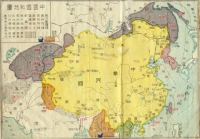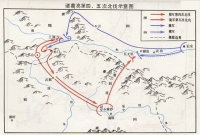 曹魏 曹魏 曹魏 曹魏 Cao Wei (Chinese: 曹魏; pinyin: Cáo Wèi; Wade–Giles: Ts'ao Wei) was one of the empires that competed for control of China during the Three Kingdoms period. With the capital at Luoyang, the empire was established by Cao Pi in 220, based upon the foundations that his father Cao Cao laid. Its name came from 213, when Cao Cao's feudal holdings were given the name Wei; historians often add the prefix Cao (曹, from Cao Cao's family name) to distinguish it from the other states in Chinese history also known as Wei, such as the earlier Wei state during the Warring States Period, and the later Northern Wei state. In 220, when Cao Pi deposed the last emperor of the Eastern Han Dynasty, Wei became the name of the new dynasty he founded, which was seized and controlled by the Sima family in 249, until it was overthrown and became part of the Jin Dynasty in 265.
History
During the decline of the Han Dynasty, the northern part of China was under the control of Cao Cao, the Imperial Chancellor to the last Han emperor . In 213, he was titled the "Duke of Wei" and was given ten cities as his domain. This area was named "Wei". At that time, the southern part of China was already divided into two areas controlled by two warlords (later Shu Han and Eastern Wu). In 216, Cao Cao was promoted to "King of Wei".
On March 15 of 220, Cao Cao died and his son Cao Pi succeeded to the title "King of Wei" and the position as Imperial Chancellor. Later that year on December 11, Cao Pi seized the imperial throne and claimed to have founded the Wei Dynasty, but Liu Bei of Shu Han immediately contested his claim to the throne, and Sun Quan of Eastern Wu followed suit in 222.
After the Sima family seized power in 249, emperor Cao Mao was the only one who tried to seize power back to his hands. He died during his coup against Sima Zhao in 260.
Wei conquered Shu Han in 263. Shortly afterwards, in 265, the Wei dynasty was overthrown by its own last Imperial Chancellor, Sima Yan, grandson of Sima Yi, who then founded the Jin Dynasty.
Culture
Sometime between the late Eastern Han Dynasty and the Cao Wei, standard or regular script (kaishu) appeared, with its first known master being Zhong Yao.
Sovereigns of Cao Wei
Cao Wèi or Kingdom of Wèi 220-265 AD Posthumous Names family (in bold) name and first names Year(s) of Reigns Era Names and their range of year
Chinese Convention: family and first names, and less commonly "Wèi" + posthumous name + "di"
Emperor Wen of Wei, ch. 文, py. wén Cao Pi, ch. 曹丕, py. cáo pī 220-226 Huangchu (黃初 huang2 chu1) 220-226
Emperor Ming of Wei, ch. 明 py. míng Cao Rui, ch. 曹叡, py. cáo rùi 226-239 Taihe (太和 tài hé) 227-233
Qinglong (青龍 qīng lóng) 233-237
Jingchu (景初 jĭng chū) 237-239
Shao (少 py. shao4) or King of Qi of Wei, ch. 齊王, py. qí wáng Cao Fang, ch. 曹芳, py. cáo fāng 239-254 Zhengshi (正始 zhèng shĭ) 240-249
Jiaping (嘉平 jīa píng) 249-254
Gaoguixiang Gong of Wei, ch. 高貴鄉公, py. gāo gùi xīang gōng Cao Mao, ch. 曹髦, py. cáo máo 254-260 Zhengyuan (正元 zhèng yúan) 254-256
Ganlu (甘露 gān lù) 256-260
Emperor Yuan of Wei, ch. 元, py. yúan Cao Huan, ch. 曹奐, py. cáo hùan 260-265 Jingyuan (景元 jĭng yúan) 260-264
Xianxi (咸熙 xían xī) 264-265
|